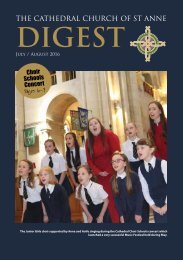Create successful ePaper yourself
Turn your PDF publications into a flip-book with our unique Google optimized e-Paper software.
Music ‘must-haves’ for Easter<br />
The dramatic events of Holy Week and<br />
Easter have been the inspiration for artists<br />
of all kinds, particularly composers<br />
across all musical periods and styles,<br />
and the selection of music for services at<br />
this time of year is a daunting task when<br />
facing such a broad wealth of repertoire.<br />
However, there are a number of works<br />
which stand out as ‘must-haves’, and<br />
two of these works, which will be sung<br />
by the Cathedral Choir during the Easter<br />
season, are the focus here.<br />
Cavalleria Rusticana was Mascagni’s<br />
first and most successful opera.<br />
Mascagni heard of a competition for a<br />
one-act opera just two months before the<br />
closing date, and submitted his entry on<br />
the very last day for submissions.<br />
Selected entries were staged, and,<br />
although it opened to a half-empty<br />
house, it was quickly recognised for the<br />
quality of both libretto and music, and<br />
the tightness of the plot, and has been a<br />
firm favourite of opera companies worldwide<br />
since.<br />
Pietro Mascagni’s<br />
‘Easter Hymn’ is a<br />
rare and welcome<br />
intrusion of the<br />
secular canon<br />
into the sacred<br />
world. The opera<br />
from which it<br />
comes, Cavalleria<br />
Rusticana<br />
(‘Rustic Chivalry’), is a tragedic portrayal<br />
of village life, adultery, and murder. It is<br />
set around a community’s celebrations<br />
of Easter Sunday, and one of the main<br />
scenes is this entirely-sacred hymn of<br />
praise during which villagers take part in<br />
a typically-European procession through<br />
their town. It begins with the Regina<br />
Coeli of the formal church service, but<br />
this quickly gives way to a less-formal<br />
and increasingly-exciting hymn:<br />
Pietro Mascagni (1863 – 1945)<br />
Inneggiamo, il Signor non è morto.<br />
Ei fulgente ha dischiuso l’avel.<br />
Inneggiamo al Signore risorto—<br />
oggi asceso alla gloria del Ciel!<br />
Let us sing hymns, the Lord is not dead.<br />
Shining, he has unsealed the tomb,<br />
Let us sing hymns to the risen Lord—<br />
ascended today to the glory of Heaven!<br />
John Taverner’s<br />
‘Dum transisset<br />
Sabbatum’ is firmly<br />
in the sacred choral<br />
music mould, but<br />
no less beautiful.<br />
The text tells<br />
of the women who<br />
came early on<br />
Easter morning to<br />
anoint Jesus with<br />
spices and found<br />
the tomb empty. At least 470-years-old,<br />
this work is a rare survival – very little<br />
pre-Reformation English cathedral music<br />
is still extant. In fact, the basis of this<br />
work is substantially older – Taverner<br />
took the plainsong melody for the text,<br />
and set it in slow notes, around which he<br />
weaved beautiful polyphony. Although<br />
the music is very ‘correct’ in its accordance<br />
with compositional techniques of<br />
the day, it still displays Taverner’s ability<br />
to respond to text – the slowly-growing<br />
opening in imitation of the rising sun, the<br />
A possible likeness of John<br />
Taverner (c. 1490 – 1545),<br />
from a c.1520 manuscript.<br />
rising and falling ‘aromata’ motif (one can<br />
almost spell the spices!), and the grand,<br />
over-lapping ‘alleluias’ all combine to<br />
make this such a wonderful piece, still<br />
performed nearly five centuries after its<br />
composition.<br />
Cathedral Digest 7




